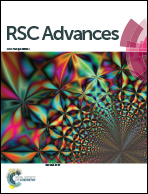Hypervalent diorganoantimony(iii) fluorides via diorganoantimony(iii) cations – a general method of synthesis†
Abstract
Novel diorganoantimony(III) fluorides containing ligands with pendant arms, R2SbF (5), (R)PhSbF (6) [R = 2-(2′,6′-iPr2C6H3N![[double bond, length as m-dash]](https://www.rsc.org/images/entities/char_e001.gif) CH)C6H4], R′′2SbF (7) and (R′′)PhSbF (8) [R′′ = 2-(Me2NCH2)C6H4], were prepared via the ionic derivatives [R2Sb]+[PF6]− (1), [(R)PhSb]+[PF6]− (2), [R′′2Sb]+[SbF6]− (4) and [(R′′)PhSb]+[SbF6]− (obtained in situ) by treatment with [Bu4N]F·3H2O. The ionic species used as starting materials as well as [R′2Sb]+[PF6]− (3) [R′ = 2-(2′,4′,6′-Me3C6H2N
CH)C6H4], R′′2SbF (7) and (R′′)PhSbF (8) [R′′ = 2-(Me2NCH2)C6H4], were prepared via the ionic derivatives [R2Sb]+[PF6]− (1), [(R)PhSb]+[PF6]− (2), [R′′2Sb]+[SbF6]− (4) and [(R′′)PhSb]+[SbF6]− (obtained in situ) by treatment with [Bu4N]F·3H2O. The ionic species used as starting materials as well as [R′2Sb]+[PF6]− (3) [R′ = 2-(2′,4′,6′-Me3C6H2N![[double bond, length as m-dash]](https://www.rsc.org/images/entities/char_e001.gif) CH)C6H4] were obtained from the corresponding bromides or chlorides and Tl[PF6] or Ag[SbF6]. The compounds were investigated by multinuclear NMR spectroscopy in solution, MS and IR spectroscopy in the solid state. The molecular structures of the ionic species 1·2CH2Cl2 and 3·2CHCl3 as well as of the fluorides 5–8 were determined by single-crystal X-ray diffraction.
CH)C6H4] were obtained from the corresponding bromides or chlorides and Tl[PF6] or Ag[SbF6]. The compounds were investigated by multinuclear NMR spectroscopy in solution, MS and IR spectroscopy in the solid state. The molecular structures of the ionic species 1·2CH2Cl2 and 3·2CHCl3 as well as of the fluorides 5–8 were determined by single-crystal X-ray diffraction.


 Please wait while we load your content...
Please wait while we load your content...